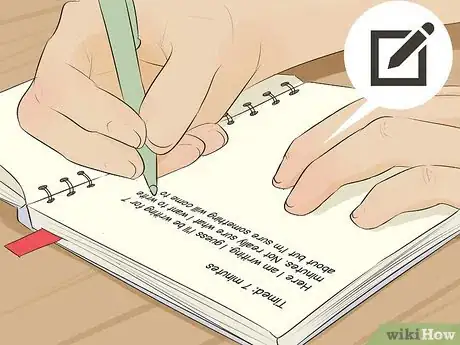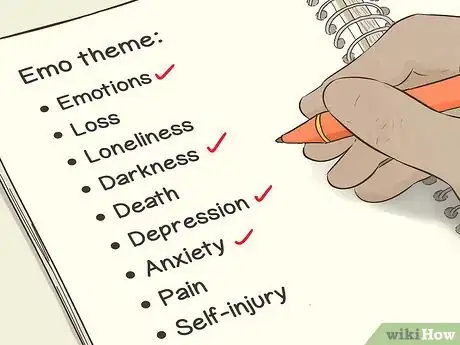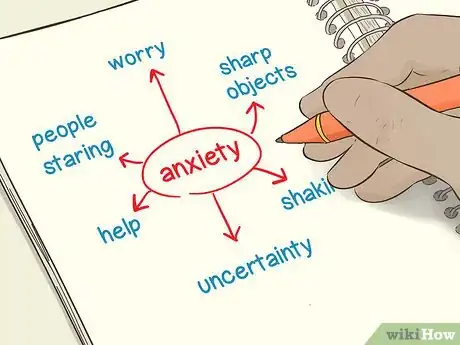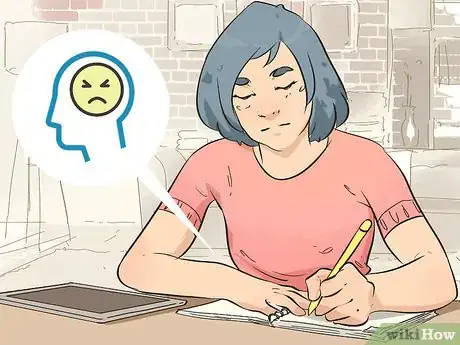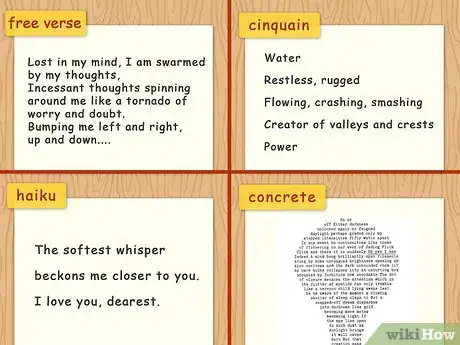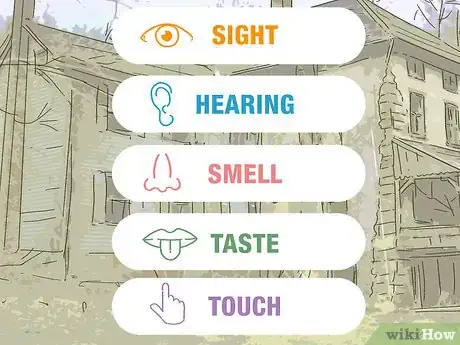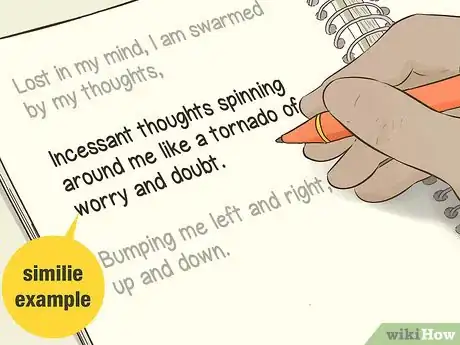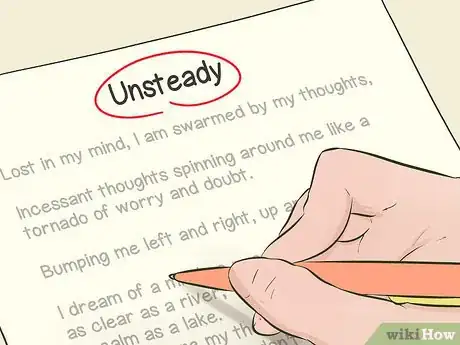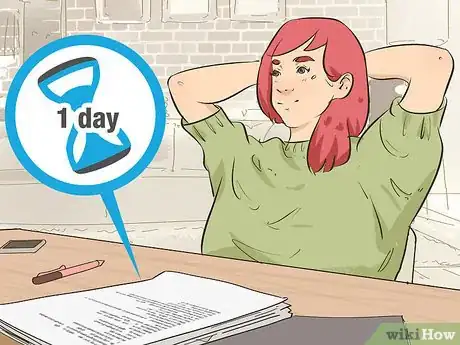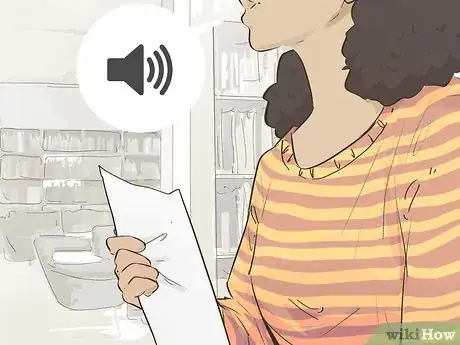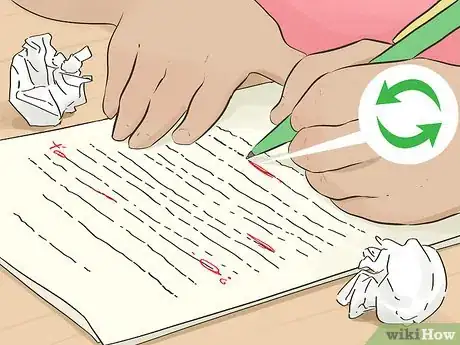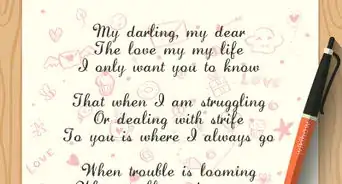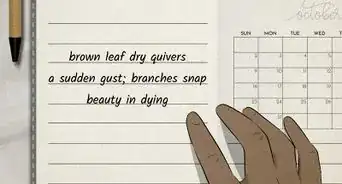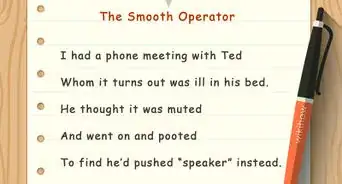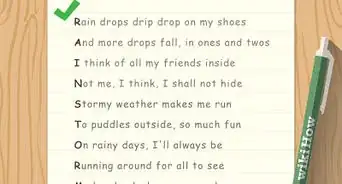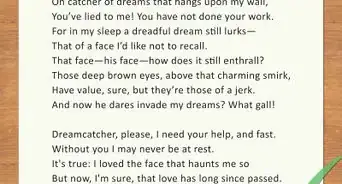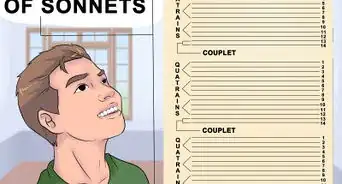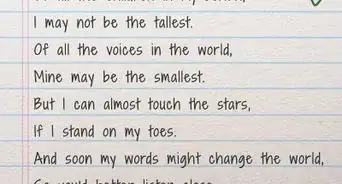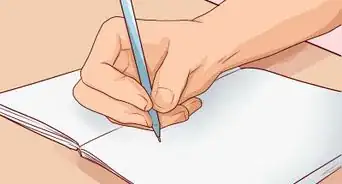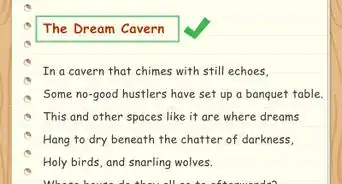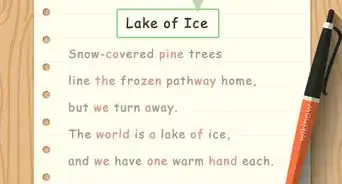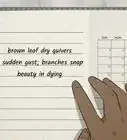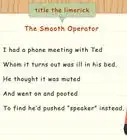This article was co-authored by wikiHow staff writer, Danielle Blinka, MA, MPA. Danielle Blinka is a Writer, Editor, Podcaster, Improv Performer, and Artist currently living in Houston, TX. She also has experience teaching English and writing to others. Danielle holds a Bachelor of Arts in English, Bachelor of Arts in Political Science, Master of Arts in English with a concentration in writing, and Master of Public Administration from Lamar University.
There are 9 references cited in this article, which can be found at the bottom of the page.
This article has been viewed 137,016 times.
Learn more...
When you think emo, you probably think of music and fashion, but you can also find emo poetry! If you want to write your own emo poem, start by brainstorming about your topic so you can identify the theme or emotion you want to explore. Then, create a draft of your poem that uses imagery and poetic devices to engage your reader. Finally, revise your poem until you’re happy with how it sounds.
Steps
Brainstorming Your Topic
-
1Use freewriting to find an emotion or theme for your emo poem. Grab a pencil and paper or open your word processor on your computer. Start writing whatever comes to mind, without worrying if it sounds right or makes sense. As you write, don’t worry about grammar or editing what you’ve written. Just keep writing until a thought or topic emerges.[1]
- Plan to write 1-3 pages during this exercise.
- You can stop freewriting when you have a topic. If you still don’t know what to write about after 3 pages, re-read what you’ve written and try to pick out a theme or emotion.
- Writing poetry may help you release your anger and frustration.
Tip: If you keep a journal, read through your last few entries to look for a theme or emotion that you’ve been dealing with lately. This might be a good inspiration for your poem.
-
2Choose a common emo theme for easy inspiration. If you’re having trouble deciding what to write about, consider using a theme that’s prevalent in emo culture. Here is a list of themes you might use:[2]
- Emotions
- Loss
- Loneliness
- Darkness
- Death
- Depression
- Anxiety
- Pain
- Self-injury
Advertisement -
3Write down words related to your theme. Brainstorm a list of words that your theme makes you think about. Include emotions, objects, images, and adjectives that are connected to this theme. List as many words as you can so you have options for what you’ll include in your poem.[3]
- Don’t worry about whether or not the words will sound good in a poem. Your goal is to get your mind thinking of possibilities.
- As an example, let's say your theme is loss. You might write down the words "missing," "pain," "emptiness," "absence," "falling," "empty room," "sacrifice," and "death."
- Similarly, if you're writing a poem about your anxiety, you might write down the words "worry," "uncertainty," "sharp objects," "people staring," "shaking," and "help."
-
4Decide on the emotions you want your reader to feel. In an emo poem, emotions are very important. Before you start your poem, choose 1 or more emotions that you want to evoke in your poem. The emotion should be connected to your theme or topic.[4]
- For instance, let’s say your poem is about feeling misunderstood. You might choose frustration, anger, and emptiness as your emotions.
- Similarly, let’s say your theme is loss. Your emotions might be pain and sadness.
Drafting an Emo Poem
-
1Decide what type of form or structure you’ll use. Emo poems are often free verse, though you may want to use end rhymes to create the sound you want. The structure you use will determine the overall sound of the poem, so you may want to try out different forms. Here are some forms you might try:[5]
- Free verse - This form has no rules, so you can use line breaks, rhyme, and stanzas however you like.
- Concrete - The body of your poem will create an image.
- Haiku - These are typically 3-line poems about nature. The first line has 5 syllables, the second line has 7 syllables, and the third line has 5 syllables.
- Villanelle - This poem has 5 stanzas with 3 lines, called tercets, followed by a stanza with 4 lines, called a quatrain. The first and third line of the first stanza will repeat throughout the poem. The repeating lines are great for evoking emotion!
-
2Choose a tone that reflects the emotion of the poem. Your tone is the mood of your poem or the attitude you take toward your topic. Emo themes tend to be a bit dark, but that doesn’t mean the tone of your poem has to be negative. Use a tone that shows the reader how you feel about your topic or theme.[6]
- For example, you could write a poem about feeling alienated from your peers that has a sarcastic tone.
- If you’re writing about losing someone you care about, your tone might be sad or angry.
- A poem that’s about death might have a frightened or sad tone.
-
3Use sensory details to evoke an emotion. Sensory details appeal to your reader’s 5 senses, so they add richness to your poem. Use details that evoke each of the 5 senses to draw your reader into your poem and help them feel the emotion you’re trying to portray. Here are some examples of lines that contain sensory details:[7]
- Sight: “Frayed edges that refuse to mend”
- Sound: “A broken bell clanging inside my mind”
- Smell: “Smelled bitter like the soil they buried you under”
- Touch: “Like ice against my skin”
- Taste: “Sweet like a cherry at first bite, then rotten on my lips”
Tip: If you’re having trouble coming up with sensory details, think of a moment when you felt the emotion you want to convey. Then, answer the following questions:
What did you see?
What do you remember smelling?
Did you hear anything?
What did you feel?
What stands out in your memory?
-
4Incorporate common poetic devices to engage your reader. Poetic devices help you create sounds and images in the minds of your readers. Try to incorporate at least 1 poetic device into your poem. As a beginner poet, focus on the following devices:[8]
- Metaphor: This is a comparison between 2 unlike things. For instance, “Today is a mountain I can’t climb.”
- Simile: Use a simile to compare 2 unlike things using “like” or “as.” As an example, “She danced like a butterfly.”
- Alliteration: This is when you use the same letter to start several words that are close together. For example, “Drinking in the darkness, diving deeper into the void.”
- Personification: You can use this to give human traits to a non-human thing. For instance, “Clouds chased me into utter darkness.”
- Repetition: Repeating a line or 2 will emphasize that line to the reader so they know it’s important.
-
5Create a title for your poem that suggests the theme or emotion. After you’ve written the first draft of your poem, read over it several times to help you decide on a title. Choose a title that reflects the theme or emotion of the poem, as well as the content. Here are some ideas for choosing a title:[9]
- Use the first line of the poem.
- If you used repetition, make the repeating line the title of your poem.
- Incorporate the theme or emotion into the title.
- For instance, a good title for a poem about loss might be "These Empty Hands" or "Without You." Similarly, a good title for a poem about your anxiety might be "Unsteady" or "An Uncertain Future."
Making Revisions
-
1Set your emo poem aside for a day or 2 before you revise it. Put your poem in a drawer or folder for safe-keeping. Don’t look at your poem for at least 24 hours before you start to revise it. This helps you see it with fresh eyes, which will help you spot areas that need improvement.[10]
- When you come back to your poem, you’ll likely notice things that you didn’t see before.
-
2Read the poem aloud to make sure it sounds emo. Poetry is all about sound, so it’s meant to be read aloud. As you read your poem aloud, make notes about what you’d like to change in your poem. Do this 2-3 times before beginning your revisions.[11]
- After each revision you make, read the poem aloud to see how it sounds.
-
3Get feedback from other poets or friends who are emo. Feedback from other people can help you improve your poetry because they’ll have a different perspective than you do. Share your poem with other poets or your friends who identify as emo. Ask them to identify passages that need revision and to tell you how the poem made them feel.[12]
- Choose people who will give you honest feedback but who also care about your feelings.
-
4Revise your poem until you feel like it expresses your emotion or theme. Use your notes and the feedback you receive to rewrite lines or stanzas that you want to improve. Similarly, eliminate unnecessary words to streamline your lines. Continue to rework your poem until you’re happy with it.[13]
- You may need to make several revisions before you feel like you have a final version of your poem.
Tip: Some people believe that a poem is never truly finished. However, don’t keep working on your poem forever. When you feel ready, share it with other people!
Community Q&A
-
QuestionWhat type of journal should I use?
 Community AnswerAny is fine, as long as it isn't pink or a lot of bright colors.
Community AnswerAny is fine, as long as it isn't pink or a lot of bright colors. -
QuestionCan I write about rainbows?
 Community AnswerYes, as long as you aren't over overly enthusiastic about them. Make them have a short list of colors, such as light gray that fades to black.
Community AnswerYes, as long as you aren't over overly enthusiastic about them. Make them have a short list of colors, such as light gray that fades to black. -
QuestionIs it appropriate to write about suicide?
 Community AnswerIt probably isn't appropriate for school, but you can write whatever you'd like for yourself.
Community AnswerIt probably isn't appropriate for school, but you can write whatever you'd like for yourself.
Warnings
- If you’re thinking about harming yourself, get help from someone you trust immediately. If you don’t have anyone you can talk to, call or text the Suicide and Crisis Lifeline at 988.⧼thumbs_response⧽
References
- ↑ https://www.writersdigest.com/tip-of-the-day/freewriting-discover-your-inner-voice-find-inspiration-to-write
- ↑ https://www.today.com/popculture/what-exactly-emo-anyway-wbna11720603
- ↑ https://penandthepad.com/write-good-emo-song-5150345.html
- ↑ https://penandthepad.com/write-good-emo-song-5150345.html
- ↑ https://www.writerscookbook.com/writing-poetry/
- ↑ https://www.writerscookbook.com/writing-poetry/
- ↑ https://penandthepad.com/sensory-imagery-mean-poetry-1667.html
- ↑ https://poets.org/poetic-devices
- ↑ http://www.public.asu.edu/~aarios/resourcebank/titles/
- ↑ https://www.writersdigest.com/whats-new/5-ways-to-revise-poems
- ↑ http://writing2.richmond.edu/writing/wweb/creativewriting/Poetry/mistakes.html
- ↑ http://writing2.richmond.edu/writing/wweb/creativewriting/Poetry/mistakes.html
- ↑ http://writing2.richmond.edu/writing/wweb/creativewriting/Poetry/mistakes.html
